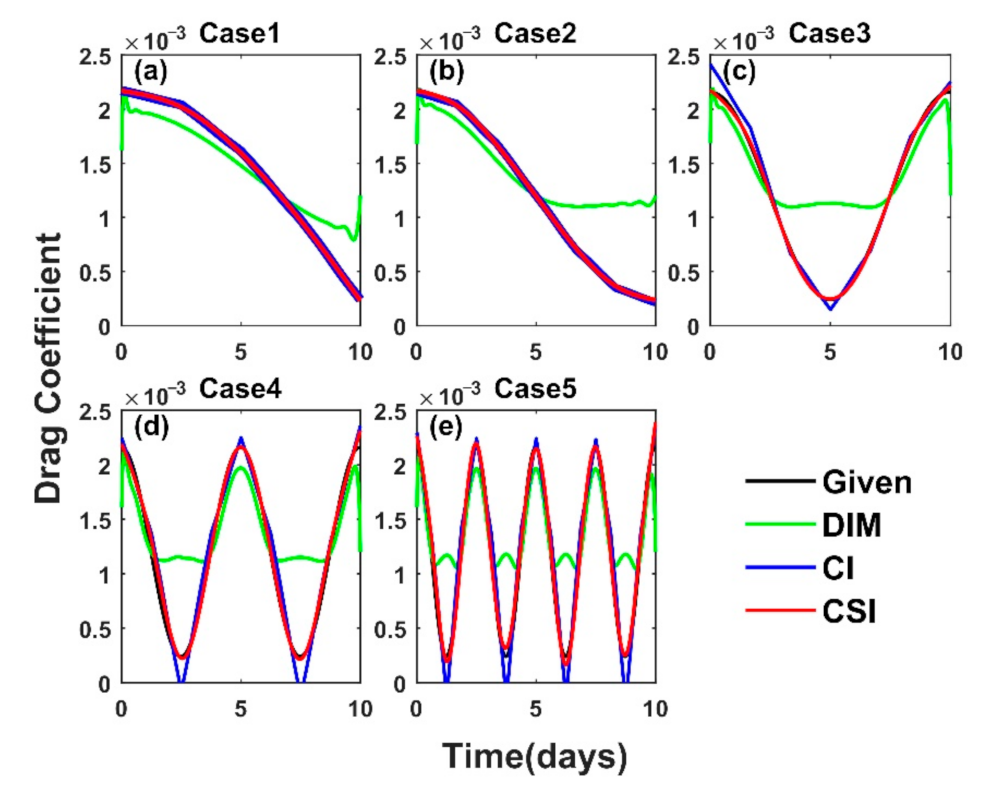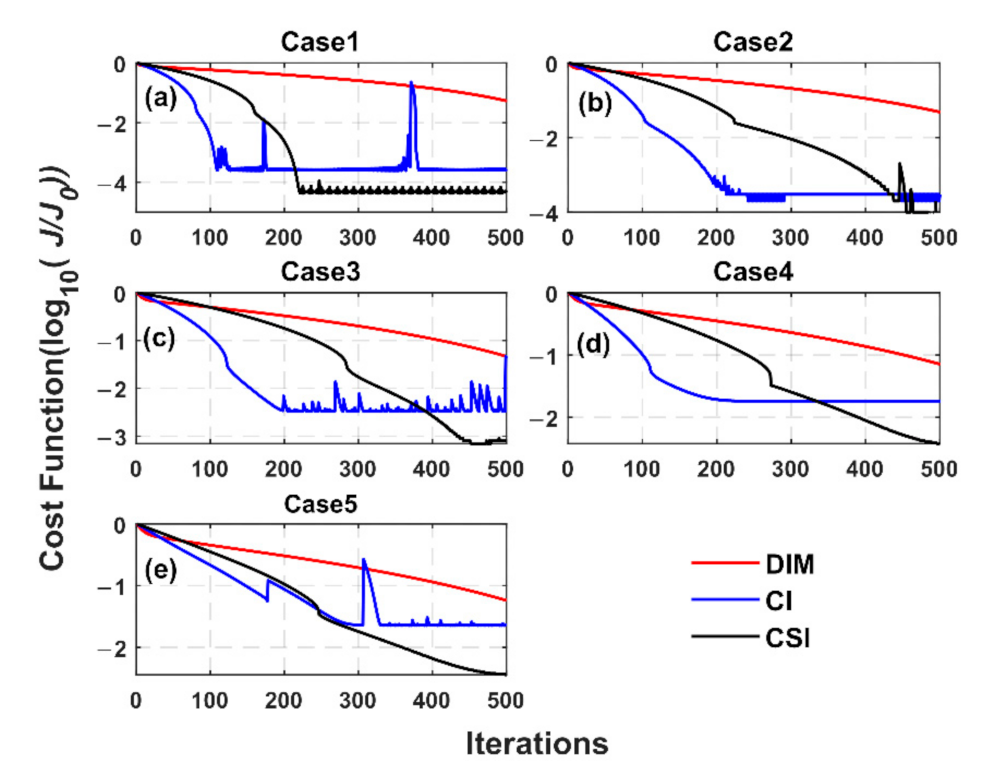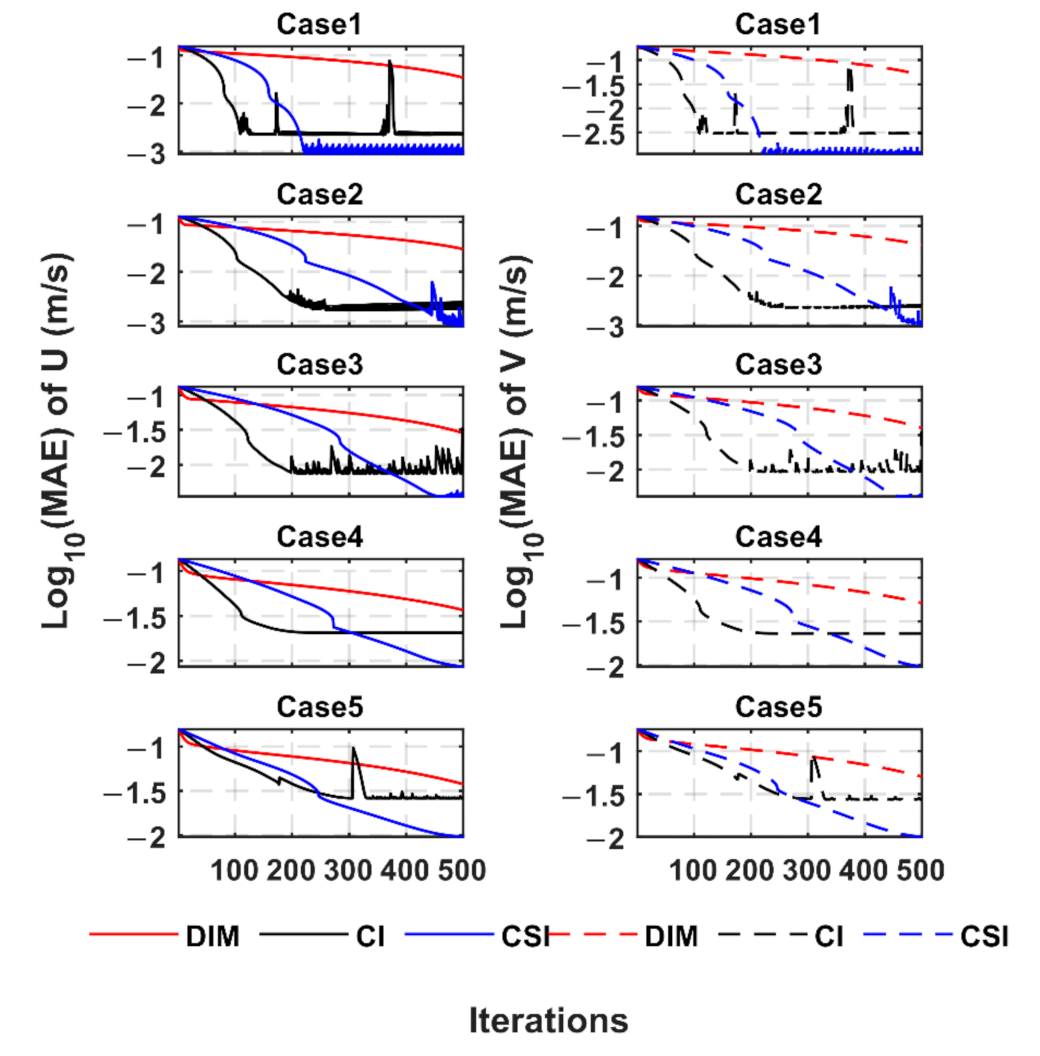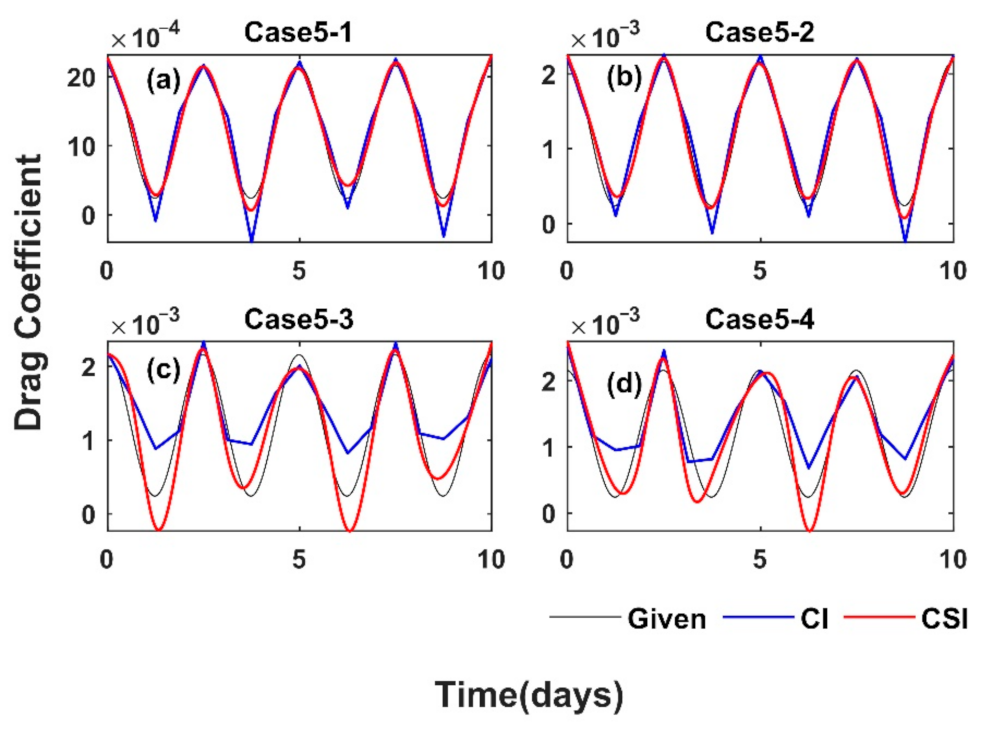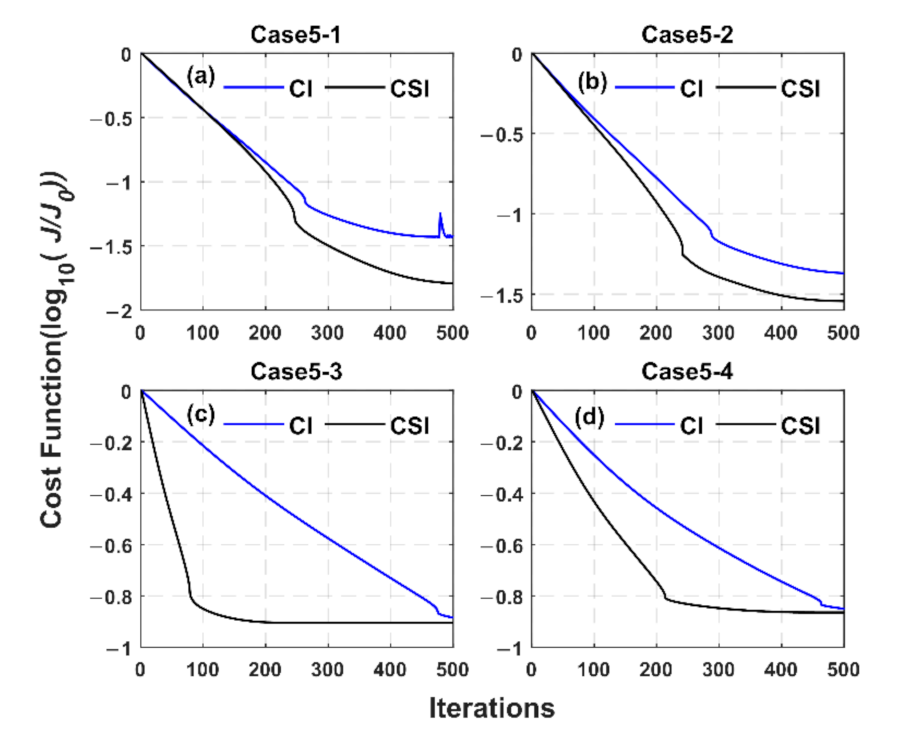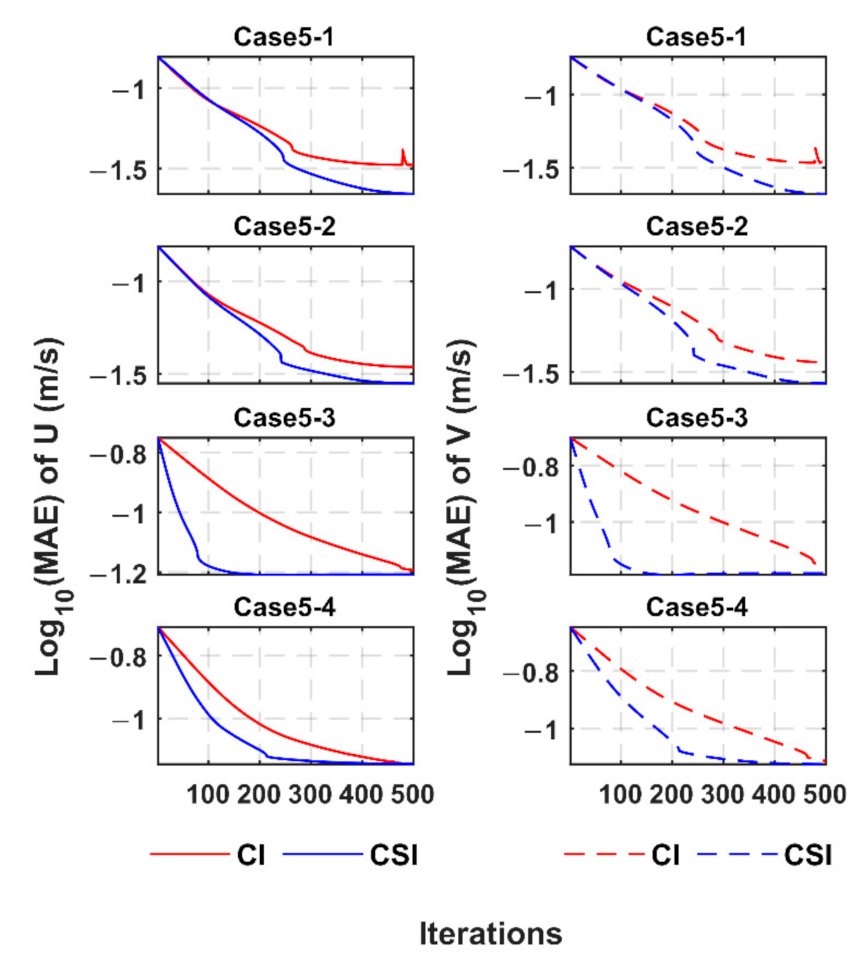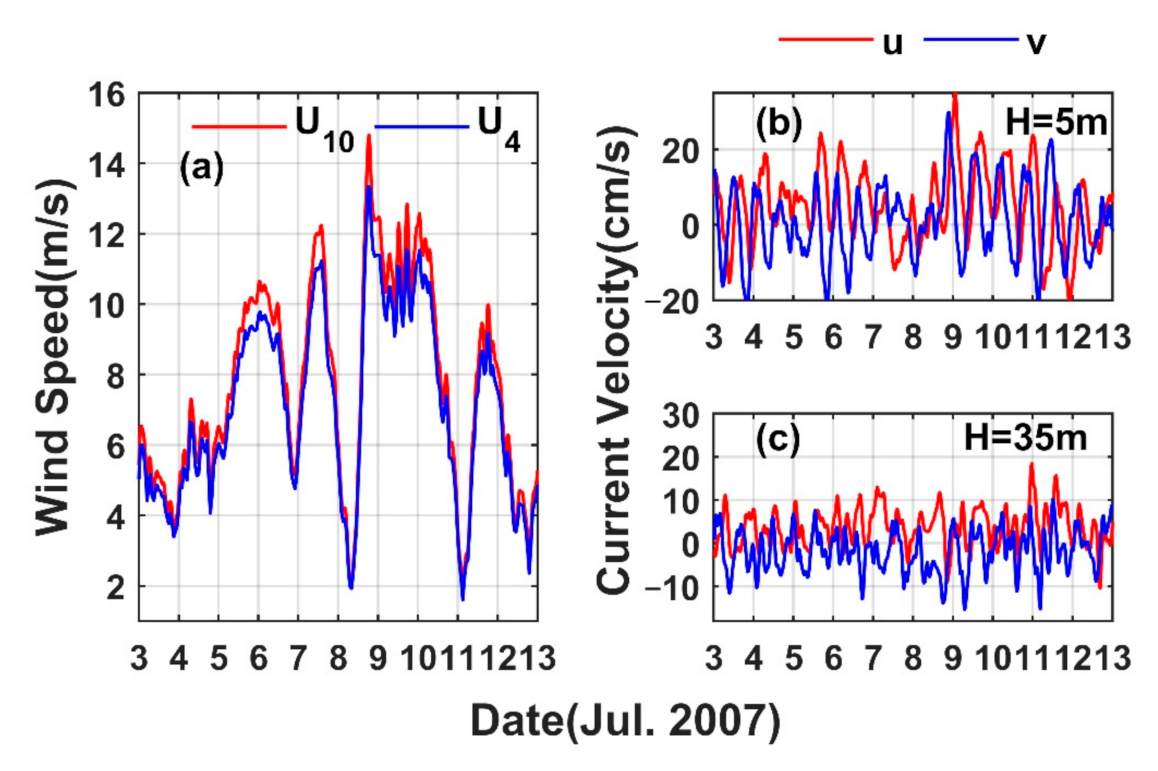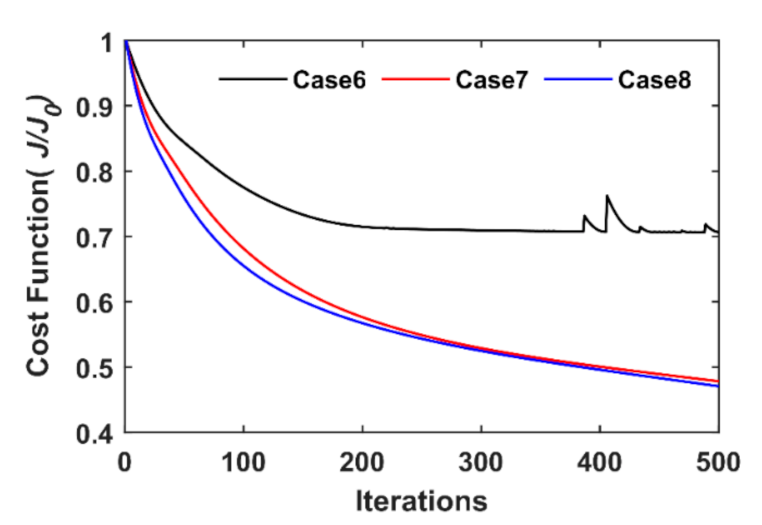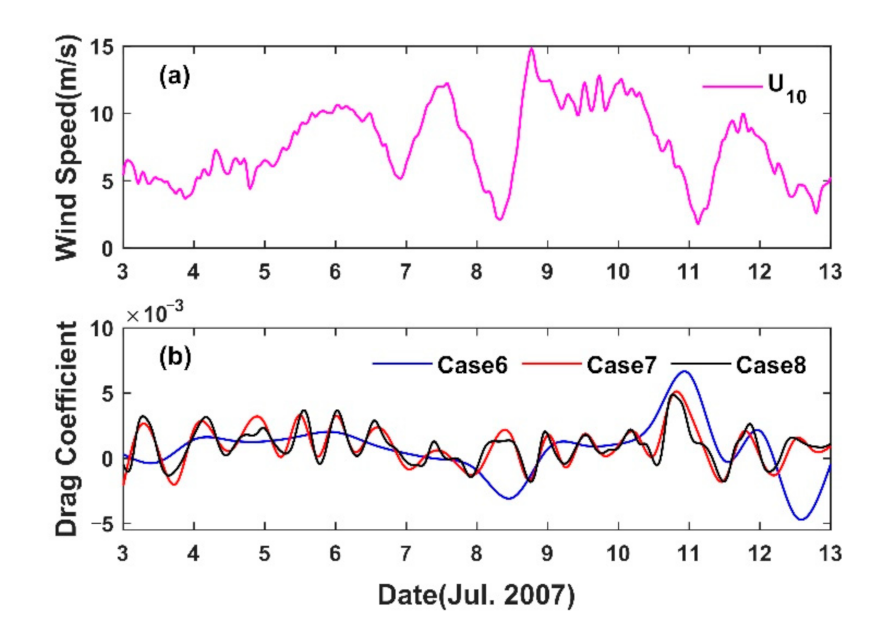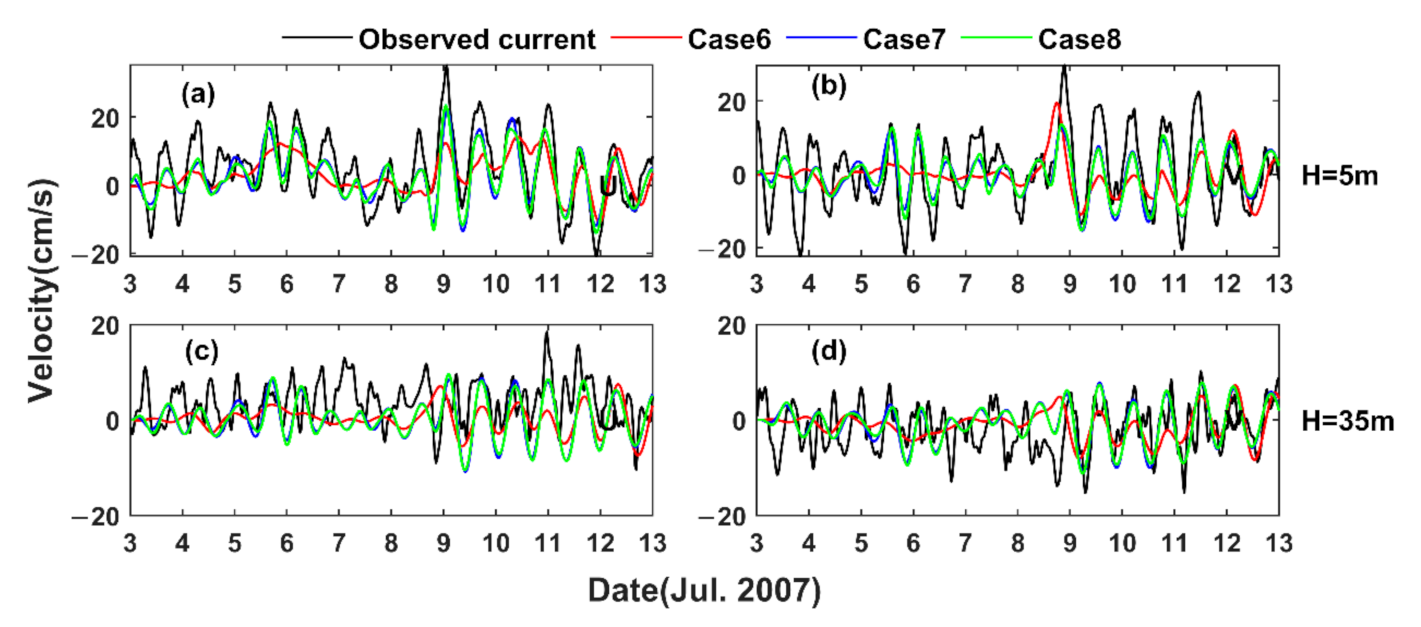3.1. Estimation of WSDCs with Different Distributions
As mentioned in the introduction, the WSDC and wind speed are time-varying. In addition, the variation of wind speed over time above the ocean is complex, and the specific distribution of the WSDC over time is unknown. Thus, we designed a group of twin experiments to verify the performance of the CSI scheme in the inversion of different prescribed WSDC distributions. Five cases of temporal WSDCs and wind speed are as follows:
where
is the same as in the inverse model.
It can be inferred that the prescribed WSDC is increasingly more complex from Case 1 to Case 5. Note that the WSDC of Case 1 is set as 0.00024 in order to keep its variation range the same as that of Cases 2–5, and wind speed only exists in the east–west direction (i.e., ).
In order to further highlight the effectiveness of the CSI scheme, experiments with direct inversion by the model (DIM, in which the WSDC at each point is independently inverted) and with Cressman interpolation (CI) schemes are also designed for comparison. The calculation formulas of the three schemes are shown in
Appendix B. The number of selected IPs with different inversion schemes for each case is shown in
Table 1. Model parameters are set in
Table 2. The main purpose of this is to estimate time-varying WSDCs in this study. As mentioned above, the time-varying eddy viscosity has been studied in previous studies, such as Zhang et al. [
21]. Therefore, we set the eddy viscosity as a variable that only varies with depth. The classical distribution of the eddy viscosity coefficient (
) can be found in the experimental results of Yu and O’Brien [
29] (
, where
is depth), which has been widely used in ocean models [
32,
33,
34]. The initial guess value of WSDC is set as 1.2 × 10
−3 in all cases. Considering that the observation data are only available at some depths (5 m and 35 m), two layers (i.e., the first and the seventh layers) of observation data are assimilated in this section. The abbreviations of some variables are shown in
Table 3.
The experimental steps are as follows:
- (1)
Run the forward model with prescribed WSDCs, and the calculated velocities are regarded as pseudo “observations”.
- (2)
Run the forward model with the initial guess value of WSDC (Cd0 = 1.2 × 10−3) to obtain the simulated values of velocity.
- (3)
Run the inverse model with the difference between the “observations” and simulations by the model. The gradients of the cost function with respect to WSDCs can be calculated according to Equation (14). By employing an optimization algorithm, the WSDC can be optimized.
- (4)
By repeating steps (2) and (3) until the inversion results meet a convergence criterion, the final inversion values of WSDC are obtained. Since the cost functions are almost no longer declining after 500 iterations, we finally selected 500-step iteration for all experiments.
The prescribed and inverted WSDCs are shown in
Figure 1. It can be seen that the prescribed distributions of WSDCs (Case 1–5) can be successfully inverted by the CI scheme and the CSI scheme, while they are partially inverted by the DIM scheme. As the distributions become increasingly more complex from Case 3 to Case 5, the consistencies between the inverted distributions obtained by the CI scheme and the prescribed distributions are getting weaker, while the inversions obtained by the CSI scheme are still in good agreement with the prescribed distributions, even at the wave peak and trough.
The mean absolute errors (MAEs) and mean relative errors (MREs) between prescribed and inverted WSDCs after assimilation are shown in
Table 4. The magnitude orders of MAEs for the DIM scheme were all 10
−4, while those for the CI scheme and CSI scheme were about 10
−5–10
−6. In Case 1, the MRE for the DIM scheme was slightly larger than 25%, and furthermore, the MREs of Case 2–5 were more than 70%, indicating that the results of the DIM scheme were poor. When the distributions were relatively simple (Case 1–3), the MREs of the CI scheme and CSI scheme were less than 6%. Thus, the reliability of the inversion results was high. In addition, the MREs of the CI scheme increased to 17.73% and 20.00% for the two complex distributions (Case 4–5), but the MREs using the CSI scheme remained at a low level (4.48% and 6.34%), which shows that the inversion results of the CSI scheme were more reliable.
We further analyzed the curves of the normalized cost function, which are shown in
Figure 2. It is shown that the cost functions for the DIM scheme were only decreased by 1–2 orders of magnitude. On the contrary, those with the CI scheme and CSI were scheme generally decreased by 2–4 orders of magnitude. The results indicate that the latter two schemes can achieve better simulation results, demonstrating better inverted WSDCs. Although the cost functions of the CSI scheme decreased more slowly than those of the CI scheme during the several early iterations, they were lower after a certain amount of iterations, indicating that the inversion effect of the CSI scheme was more advantageous.
The above results indicate that the CSI scheme showed good inversion ability for WSDCs of different complexities. Here, the simulation ability of current velocity was also assessed. The variations of the MAEs of the horizontal current velocity components (u and v) with the iterations are shown in
Figure 3. It can be seen that the MAEs of the CI scheme and the CSI scheme in Cases 1–5 were obviously smaller than those of the DIM scheme. In cases 1–3, the MAEs of the CI scheme decreased more rapidly with increased iteration steps, but the final values of the MAEs were at the same level as those of the CSI scheme. However, for the relatively complex distributions (cases 4–5), the MAEs of the CSI scheme were still smaller than those of the CI scheme.
In conclusion, the prescribed distributions of WSDCs can successfully be inverted by the adjoint method with CI or CSI schemes even if only two layers of data are assimilated. As the WSDCs from Case 1 to Case 5 were increasingly more complex, the CSI scheme obtained the best inversion result, and the CI scheme followed. At the same time, the DIM scheme obtained the worst inversion, again indicating that the IP scheme is an effective tool in parameter estimation based on the adjoint method.
3.2. Estimation of WSDCs under Different Observation Noise
In all the above cases, the perfect observations without any noise were directly produced by the forward model. However, there was noise in the actual observations of current velocity and wind speed, which might have affected the inversion results. Zhang and Lu [
35] indicated that the average difference between the inversion results and true values would increase abnormally, so long as observation errors increased to a certain level. Therefore, we designed another group of experiments to investigate the potential effect of different data noise on WSDC estimation. Considering the distribution complexity, the WSDC in Case 5 was adopted in this group. Gaussian white noise was added to observations of current velocity
,
and wind speed
, respectively, representing the observation errors in the real ocean. Specifically, errors with different ratios to each observation value were added to the perfect observations (shown in
Table 5). Since group 1 showed that the CI and the CSI schemes were significantly better than the DIM scheme, the former two schemes were used in this group.
The prescribed and inverted WSDCs for different observation noise are shown in
Figure 4, and the correlation coefficients between them are shown in
Table 6. It is clear that the prescribed distributions could be inverted successfully by the CI and CSI schemes in Case 5–1 and Case 5–2. However, in Case 5–3 and Case 5–4, the curves inverted with the CI scheme oscillated more violently than those with the CSI scheme, indicating that the inversion accuracy of the CSI scheme was higher than that of the CI scheme. Combining these results with
Figure 4 and
Table 6, it could be found that the CSI scheme was more advantageous, especially in Case 5–3 and Case 5–4. Moreover, the distortions of both schemes began to increase significantly with increasing noise level.
Additionally, it can be found in
Figure 5 that the normalized cost functions decline greatly with the iterations. Specifically, at most iterations, the cost functions of the CSI scheme are smaller than those of the CI scheme, indicating that the current velocities simulated by the CSI scheme are closer to the observation. This further reveals the superiority of the CSI scheme.
Additionally, the MAEs for the horizontal velocity are shown in
Figure 6. It can be seen that, after 200 iterations, the MAEs of the CSI scheme in Case 5-1 were notably smaller than those of the CSI scheme, suggesting that the CSI scheme was more advantageous than the CI scheme.
To sum up, the prescribed distributions of the WSDCs could still be well inverted by the CSI scheme even there were moderate noises in the observations. With the increase in observation errors, the performance of the CSI scheme became worse. Still, the CSI scheme showed a more stable tolerance of observation noise than the CI scheme.
